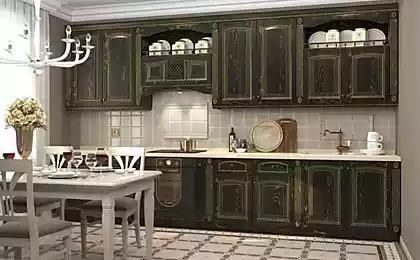152
The Hellish Cons of Submersible Blenders
Not long ago I had the pleasure of buying a blender. But the joy of buying evaporated like dew in the sun, faced with the misunderstanding of others. “Why do you need a stationary, there is no use in it, in vain only threw money away,” read his verdict, running for tea sister. “Okay, just a little space. And so there is nowhere to turn, the wife struck from the rear. How to choose a blender and not regret it? The answers are in our article.

If I was a sultan, I would buy a blender of each kind. But the shortage of living space and banknotes forces us to focus on one option. And to make an informed choice, you need to assess your needs, as well as compare the strengths and weaknesses of all models.

Before going to the store it is advisable to ask yourself a number of questions.
Stationary blender blender jug perfectly copes with the preparation of smoothies, cocktails, baby food. But this scope of its application is far from exhausting. For example, I like to mix liquid pancake dough in it.

In stationary blenders, you can also prepare mashed soups, sauces, grind fruits and (in some models) ice. A large and tightly closing bowl of such a blender determines most of its advantages: you can cook 6 or more glasses of a cocktail at a time, the products do not splash (if you close the lid tightly), the blender is not necessarily kept in your hands all the time.

For families with small children, it will be important that a stationary blender is safer than a manual blender. After all, reaching with your hands to the knives at the bottom of the jug is not an easy task.

Another advantage of jugs I see is that they always stand on the table in a assembled and ready to work. You do not need to look for parts of the submersible blender in the drawers of the table, choose a nozzle, collect, look for the right glass. Wanted a cocktail, poured milk, threw a banana, pressed the button and voila, the treat is ready.
The disadvantages of stationary blenders include the occupied place, less versatility, the need to pour into them (as in the case of soups) crushed products.
Submersible blender Manual blender, or (how rich the Russian language) “blender with a leg”, copes with most household kitchen tasks: makes mince, homemade mayonnaise, puree and dough, beats eggs and crushes ice. Even more expand its scope of application special nozzles: a corolla, a grinder, a coffee mill and the like.

Typically, a submersible blender is a lightweight and compact device that is easily disassembled and assembled if necessary. Conveniently, small portions of products they can grind in any dish. For example, potatoes can be grinded in a saucepan or quickly mixed in a bowl of ingredients for baking.

Therefore, many housewives not without reason consider a blender with an extensive set of nozzles a reasonable alternative to a bulky food processor and most often opt for this model. Well, the disadvantages: a submersible blender, unlike a stationary one, must be kept in your hands all the time, they are not so comfortable preparing large portions of cocktails and smoothies, with careless use, liquid products are sprayed.
As you can see, it is impossible to say that a submersible or stationary blender is definitely better. After all, each model has its pros and cons. Decide what is more important for you at this stage: cocktails or baking. And then choose the device that most fully satisfies your needs.

If I was a sultan, I would buy a blender of each kind. But the shortage of living space and banknotes forces us to focus on one option. And to make an informed choice, you need to assess your needs, as well as compare the strengths and weaknesses of all models.

Before going to the store it is advisable to ask yourself a number of questions.
- How often do you plan to use a blender?
- For what purpose will you use the kitchen appliance?
- Is there free space on your kitchen countertop?
- How much money are you willing to spend on buying?
Stationary blender blender jug perfectly copes with the preparation of smoothies, cocktails, baby food. But this scope of its application is far from exhausting. For example, I like to mix liquid pancake dough in it.

In stationary blenders, you can also prepare mashed soups, sauces, grind fruits and (in some models) ice. A large and tightly closing bowl of such a blender determines most of its advantages: you can cook 6 or more glasses of a cocktail at a time, the products do not splash (if you close the lid tightly), the blender is not necessarily kept in your hands all the time.

For families with small children, it will be important that a stationary blender is safer than a manual blender. After all, reaching with your hands to the knives at the bottom of the jug is not an easy task.

Another advantage of jugs I see is that they always stand on the table in a assembled and ready to work. You do not need to look for parts of the submersible blender in the drawers of the table, choose a nozzle, collect, look for the right glass. Wanted a cocktail, poured milk, threw a banana, pressed the button and voila, the treat is ready.
The disadvantages of stationary blenders include the occupied place, less versatility, the need to pour into them (as in the case of soups) crushed products.
Submersible blender Manual blender, or (how rich the Russian language) “blender with a leg”, copes with most household kitchen tasks: makes mince, homemade mayonnaise, puree and dough, beats eggs and crushes ice. Even more expand its scope of application special nozzles: a corolla, a grinder, a coffee mill and the like.

Typically, a submersible blender is a lightweight and compact device that is easily disassembled and assembled if necessary. Conveniently, small portions of products they can grind in any dish. For example, potatoes can be grinded in a saucepan or quickly mixed in a bowl of ingredients for baking.

Therefore, many housewives not without reason consider a blender with an extensive set of nozzles a reasonable alternative to a bulky food processor and most often opt for this model. Well, the disadvantages: a submersible blender, unlike a stationary one, must be kept in your hands all the time, they are not so comfortable preparing large portions of cocktails and smoothies, with careless use, liquid products are sprayed.
As you can see, it is impossible to say that a submersible or stationary blender is definitely better. After all, each model has its pros and cons. Decide what is more important for you at this stage: cocktails or baking. And then choose the device that most fully satisfies your needs.























